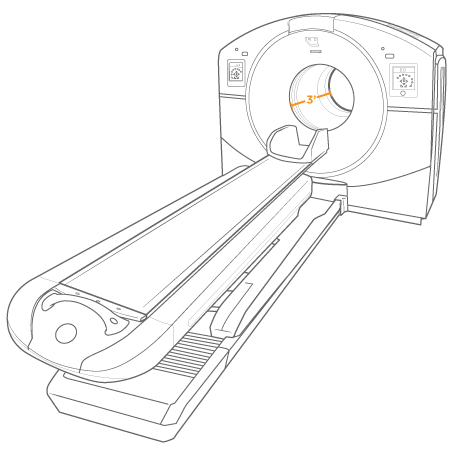This information will help you get ready for your positron emission tomography (PET) computed tomography (CT) scan with FDG tracer at MSK.
About your PET-CT with FDG tracer
A PET-CT scan is an imaging procedure that is used to:
- Find cancer cells.
- Plan your treatment.
- See how your treatment is working.
You’ll have a CT scan with a low dose of radiation at the same time as your PET scan. CT scans take a fast series of X-ray pictures. They’re combined with your PET scan to create pictures of your soft tissues and bones.
You may also be scheduled for a diagnostic CT at the same time as your PET-CT. A diagnostic CT lets your healthcare provider learn more about your tissues, bones, and blood vessels. Ask your healthcare provider for the resource Computed Tomography (CT) Scan to help you get ready.
Tracer
Before your PET-CT, you’ll get a radioactive medication called a tracer. The tracer is attached to a substance that your cells and tissues use. Cancer cells do not use the substance the same way as healthy cells. The radioactive part of the tracer lets your healthcare provider see how your cells are using the substance. This helps them find cancer cells.
Your PET-CT will use FDG as the tracer. You will get the tracer through a catheter (thin, flexible tube). The catheter may be an intravenous (IV) line in your arm, hand, or central venous catheter (CVC), if you have one.
The tracer is used by your cells and does not stay in your body long. It leaves your body mainly through your urine.
Oral contrast
You will get oral contrast to drink before your scan. You’ll be asked if you’re allergic to iodinated contrast when you check in for your appointment. You’ll get one of the following oral contrast solutions:
- Iodinated contrast (contrast with iodine)
- Diluted barium sweetened with saccharin
Both types of contrast work the same way and are used for the same purpose. Both are safe if you have diabetes.
You’ll need to start drinking the oral contrast 45 to 60 minutes before your PET-CT. This will give the contrast solution time to move through your body.
Getting ready for your PET-CT with FDG tracer
Breastfeeding and pregnancy
Tell your healthcare provider if you’re pregnant or breastfeeding. This will help them plan your care.
Diabetes care
If you have diabetes, talk to your doctor who ordered your test. They will tell you how to manage your medicine before your PET-CT.
Take devices off your skin
You may wear certain devices on your skin. Before your scan or procedure, device makers recommend you take off your:
- Continuous glucose monitor (CGM)
- Insulin pump
Talk with your healthcare provider about scheduling your appointment closer to the date you need to change your device. Make sure you have an extra device with you to put on after your scan or procedure.
You may not be sure how to manage your glucose while your device is off. If so, before your appointment, talk with the healthcare provider who manages your diabetes care.
What to do the day before your PET-CT with FDG tracer
Avoid doing some activities the day before
For 24 hours before your scan, avoid activity that uses a lot of energy or makes you repeat motions. This includes running, jogging, or cycling. These activities can lower the quality of the images from your PET-CT.
Stay warm
It’s important to stay warm the day before and the day of your scan. When you get cold, it affects a special type of fat. Staying warm will keep the fat from making it harder for your radiologist to get clear images from your PET-CT. A radiologist is a doctor with special training in using imaging to diagnose and treat disease.
Follow these instructions:
- Avoid areas where you may become too cold.
- Keep your hands and feet warm at all times.
- In the winter, dress extra warmly. Wear hats, scarves, gloves, and extra layers.
- In the summer, avoid turning on your air conditioner very high.
- Bring a sweater with you to your appointment.
If you’re getting anesthesia (A-nes-THEE-zhuh), read the “For people getting anesthesia” section at the end of this resource. Anesthesia is medicine to numb you or make you sleep.
What to do the day of your PET-CT with FDG tracer
Avoid activity that uses a lot of energy or makes you repeat motions until after your scan.
If you are not getting anesthesia, follow the instructions below. You may not be able to have your PET-CT if you do not follow these instructions before your procedure.
For 6 hours before you arrive for your scan:
- Do not eat anything.
- Do not chew gum or suck on hard candy, mints, or cough drops.
- You may drink only water.
- If you take medications, take them with water only.
If you are getting anesthesia, read the “For people getting anesthesia” section at the end of this resource.
What to expect when you arrive
Many staff members will ask you to say and spell your name and birth date. This is for your safety. People with the same or similar names may be having a procedure on the same day. Once you’re in the department, you’ll fill out a brief questionnaire.
Your care team will prick your finger or draw blood from your arm to measure your blood glucose (sugar). It is measured in milligrams per deciliter (mg/dL). Your blood sugar level needs to be between 70 mg/dL and 199 mg/dL.
If your blood sugar level is 200 mg/dL or above, you may need to get insulin. Your scan may need to be rescheduled if your blood sugar level is above 200 mg/dL or below 70 mg/dL.
Your care team will inject the tracer into your vein. You’ll wait about 60 minutes (1 hour) for your body to absorb the tracer. The amount of time depends on which area of your body will be scanned. You will also get contrast to drink at this time.
Try to relax and limit your movement during this time. You can sleep, read, listen to music, or watch videos while you’re waiting. Ask for a blanket if you feel cold.
If you’re having a brain PET-CT, it’s important to limit brain activity before your scan. Your nurse may tell you not to read or listen to music while you’re waiting for your scan.
Your care team will ask you to urinate (pee) just before your scan.
During your PET-CT with FDG tracer
When it’s time for your scan, your technologist will bring you to the scanning room. They will help you onto the scanning table.
The machine looks like a large doughnut with a hole in the middle (see figure 1). This is the scanning ring (scanner). The scanner is about 3 feet (1 meter) deep.

Figure 1. PET-CT machine
Once you’re on the scanning table, the table will move slowly through the scanning ring. You must lie very still until your scan is done. This can take 30 to 45 minutes, depending on the type of scan you’re having.
If you’re also scheduled for a diagnostic CT scan, you’ll get a contrast infusion through your IV or CVC. An infusion is when medicine is slowly put into your bloodstream. This will happen after your technologist takes the first series of pictures.
To learn more, read Computed Tomography (CT) Scan.
What to do after your PET-CT with FDG tracer
You can leave as soon as your scan is done, unless you have other tests or procedures scheduled. You’ll get a card stating you had a test with a radioactive tracer and your test date. Keep this card with you because some security equipment can find radioactivity until it leaves your body. This should take less than a day.
Remember to stay hydrated after your scan. Drink water and other liquids throughout the rest of the day to help remove the tracer from your body. You can go back to your normal diet right away, unless you’re given other instructions.
It is safe to be around people who are older than 18 years old. You can spend time near others, kiss, hug, hold, and touch them.
For 1 hour after your scan:
- Do not hold (have skin-to-skin contact with) a pregnant person or anyone younger than 18 years old.
- Do not sleep in the same bed with a pregnant person or anyone younger than 18 years old.
Instructions for people who are breastfeeding
Stop breastfeeding for 4 hours after your scan.
During that time, you can still express (pump) milk. You can then either throw away the pumped milk or store it for the same amount of time breastfeeding is paused before giving it to the baby. During this time, you can feed the baby with previously expressed milk or formula.
Your PET-CT results
A radiologist will read your scan and send your results to your doctor. If your PET-CT was done to find cancer cells, your doctor should have your results in 2 business days. Ask your doctor how they will share your results with you. If your PET-CT was done to plan your treatment, your doctor will use the images to plan your care.
For people getting anesthesia | ||||||
|---|---|---|---|---|---|---|
Follow these instructions if you are getting anesthesia (medication to make you sleep) during your PET-CT. What to do the day before your PET-CTArrange for someone to take you homeYou must have a responsible care partner take you home after your procedure. A responsible care partner is someone who can help you get home safely. They should be able to contact your care team if they have any concerns. Make sure to plan this before the day of your procedure. If you don’t have a responsible care partner to take you home, call one of the agencies below. They’ll send someone to go home with you. There’s a charge for this service, and you’ll need to provide transportation. It’s OK to use a taxi or car service, but you still need a responsible care partner with you.
Instructions for eatingStop eating at midnight (12 a.m.) the night before your procedure. This includes hard candy and gum. What to do the day of your PET-CTInstructions for drinkingBetween midnight (12 a.m.) and 6 hours before your arrival time, only drink the liquids on the list below. Do not eat or drink anything else.
If you have diabetes, pay attention to the amount of sugar in these drinks. It will be easier to control your blood sugar levels if you include sugar-free, low-sugar, or no added sugar versions of these drinks. 6 hours before your arrival time, do not drink anything except water. It’s helpful to stay hydrated before surgery, so drink if you are thirsty. Do not drink more than you need. You will get intravenous (IV) fluids during your surgery.
|
Contact information
If you have any questions or concerns, call the Molecular Imaging and Therapy Service (MITS, or the Nuclear Medicine service) at 212-639-6652. You can reach a staff member Monday through Friday from to After , during the weekend, and on holidays, call 212-639-2000.
